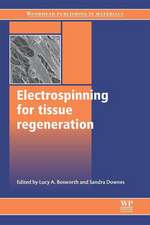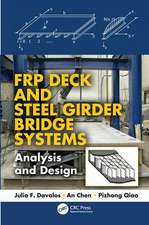Biomedical Hydrogels: Biochemistry, Manufacture and Medical Applications: Woodhead Publishing Series in Biomaterials
Editat de Steve Rimmeren Limba Engleză Paperback – 19 aug 2016
Part one of this book concentrates on the processing of hydrogels, covering hydrogel swelling behaviour, superabsorbent cellulose-based hydrogels and regulation of novel hydrogel products, as well as chapters focusing on the structure and properties of hydrogels and different fabrication technologies. Part two covers existing and novel applications of hydrogels, including chapters on spinal disc and cartilage replacement implants, hydrogels for ophthalmic prostheses and hydrogels for wound healing applications. The role of hydrogels in imaging implants in situ is also discussed.
With its distinguished editor and international team of contributors, Biomedical hydrogels is an excellent reference for biomedical research scientists and engineers in industry and academia, as well as others involved in research in this area, such as research clinicians.
- Examines the diverse range and use of hydrogels, focusing on processing methods and novel applications
- Comprehensive book explores the structure and properties of hydrogels and different fabrication technologies
- Covers important areas such as processing of hydrogels, covering hydrogel swelling behaviour, superabsorbent cellulose-based hydrogels and regulation of novel hydrogel products
Din seria Woodhead Publishing Series in Biomaterials
- 5%
 Preț: 1209.61 lei
Preț: 1209.61 lei - 9%
 Preț: 1288.81 lei
Preț: 1288.81 lei - 20%
 Preț: 1116.12 lei
Preț: 1116.12 lei - 36%
 Preț: 1030.16 lei
Preț: 1030.16 lei - 5%
 Preț: 1403.92 lei
Preț: 1403.92 lei - 26%
 Preț: 990.05 lei
Preț: 990.05 lei - 5%
 Preț: 1047.40 lei
Preț: 1047.40 lei - 5%
 Preț: 1097.68 lei
Preț: 1097.68 lei - 9%
 Preț: 1159.07 lei
Preț: 1159.07 lei - 5%
 Preț: 1341.04 lei
Preț: 1341.04 lei - 5%
 Preț: 1116.94 lei
Preț: 1116.94 lei - 5%
 Preț: 1115.67 lei
Preț: 1115.67 lei - 20%
 Preț: 901.66 lei
Preț: 901.66 lei - 5%
 Preț: 1114.31 lei
Preț: 1114.31 lei - 26%
 Preț: 903.89 lei
Preț: 903.89 lei - 36%
 Preț: 939.94 lei
Preț: 939.94 lei - 5%
 Preț: 1511.72 lei
Preț: 1511.72 lei - 5%
 Preț: 1071.15 lei
Preț: 1071.15 lei - 9%
 Preț: 1090.57 lei
Preț: 1090.57 lei - 9%
 Preț: 1044.12 lei
Preț: 1044.12 lei - 29%
 Preț: 847.49 lei
Preț: 847.49 lei - 9%
 Preț: 1003.98 lei
Preț: 1003.98 lei - 5%
 Preț: 1050.99 lei
Preț: 1050.99 lei - 5%
 Preț: 1600.80 lei
Preț: 1600.80 lei - 5%
 Preț: 986.00 lei
Preț: 986.00 lei - 5%
 Preț: 1118.83 lei
Preț: 1118.83 lei - 5%
 Preț: 1050.99 lei
Preț: 1050.99 lei - 20%
 Preț: 1038.08 lei
Preț: 1038.08 lei - 5%
 Preț: 902.90 lei
Preț: 902.90 lei - 9%
 Preț: 1070.42 lei
Preț: 1070.42 lei - 5%
 Preț: 1512.75 lei
Preț: 1512.75 lei - 29%
 Preț: 1282.87 lei
Preț: 1282.87 lei - 25%
 Preț: 1121.07 lei
Preț: 1121.07 lei - 5%
 Preț: 1253.32 lei
Preț: 1253.32 lei - 9%
 Preț: 1204.85 lei
Preț: 1204.85 lei - 26%
 Preț: 1046.86 lei
Preț: 1046.86 lei - 5%
 Preț: 835.44 lei
Preț: 835.44 lei - 5%
 Preț: 838.79 lei
Preț: 838.79 lei - 5%
 Preț: 940.93 lei
Preț: 940.93 lei - 20%
 Preț: 1290.67 lei
Preț: 1290.67 lei - 5%
 Preț: 940.63 lei
Preț: 940.63 lei - 5%
 Preț: 1115.22 lei
Preț: 1115.22 lei - 5%
 Preț: 989.25 lei
Preț: 989.25 lei - 20%
 Preț: 1598.75 lei
Preț: 1598.75 lei - 20%
 Preț: 964.40 lei
Preț: 964.40 lei - 20%
 Preț: 903.00 lei
Preț: 903.00 lei - 5%
 Preț: 1333.41 lei
Preț: 1333.41 lei
Preț: 847.30 lei
Preț vechi: 1328.15 lei
-36% Nou
Puncte Express: 1271
Preț estimativ în valută:
162.14€ • 173.37$ • 135.18£
162.14€ • 173.37$ • 135.18£
Carte tipărită la comandă
Livrare economică 10-24 aprilie
Preluare comenzi: 021 569.72.76
Specificații
ISBN-13: 9780081017418
ISBN-10: 0081017413
Pagini: 288
Dimensiuni: 156 x 234 x 15 mm
Greutate: 0.4 kg
Editura: ELSEVIER SCIENCE
Seria Woodhead Publishing Series in Biomaterials
ISBN-10: 0081017413
Pagini: 288
Dimensiuni: 156 x 234 x 15 mm
Greutate: 0.4 kg
Editura: ELSEVIER SCIENCE
Seria Woodhead Publishing Series in Biomaterials
Cuprins
Part I: Processing of hydrogels
Chapter 1: Hydrogel swelling behavior and its biomedical applications
Abstract:
1.1 Basics of hydrogels
1.2 Swelling of hydrogels: water diffusion into hydrogels
1.3 Stimulus-responsive hydrogels
1.4 Examples of environment-sensitive hydrogels
1.5 Future trends
Chapter 2: Superabsorbent cellulose-based hydrogels for biomedical applications
Abstract:
2.1 Introduction
2.2 Cellulose-based hydrogels and crosslinking strategies
2.3 Hydrogel properties and thermodynamics
2.4 Applications
2.5 Conclusions
Chapter 3: Synthesis of hydrogels for biomedical applications: control of structure and properties
Abstract:
3.1 Introduction
3.2 Cross-linking of high molecular weight polymers
3.3 Copolymerization with multi-functional monomers
3.4 Multiphase hydrogels
3.5 Functional hydrogels
3.6 Conclusion
Chapter 4: Processing and fabrication technologies for biomedical hydrogels
Abstract:
4.1 Introduction
4.2 Applications
4.3 Gelation
4.4 Physical crosslinking
4.5 Photopolymerization and photopatterning
4.6 Stereolithography
4.7 Two-photon laser scanning photolithography
4.8 Processing of multicomponent hydrogels
4.9 Future trends
4.10 Acknowledgements
Chapter 5: Regulation of novel biomedical hydrogel products
Abstract:
5.1 Introduction
5.2 Regulatory jurisdictions
5.3 Regulatory frameworks
5.4 Risk-based device classification
5.5 Non-clinical testing
5.6 Clinical data and studies
5.7 Marketing authorization processes
5.8 Quality system requirements
5.9 Post-market requirements
5.10 Future trends
5.11 Sources of further information and advice
Part II: Applications of hydrogels
Chapter 6: Spinal disc implants using hydrogels
Abstract:
6.1 Introduction
6.2 Intervertebral disc
6.3 Disc implant
6.4 Conclusion
Chapter 7: Hydrogels for intraocular lenses and other ophthalmic prostheses
Abstract:
7.1 Introduction
7.2 Intraocular lenses
7.3 Vitreous substitutes
7.4 Tissue adhesives
7.5 Conclusions
7.5 Acknowledgements
Chapter 8: Cartilage replacement implants using hydrogels
Abstract:
8.1 Introduction
8.2 Historical background in cartilage repair and injury: existing therapies
8.3 First and second generation tissue engineering
8.4 Third generation tissue engineering
8.5 Future trends
Chapter 9: Hydrogels for wound healing applications
Abstract:
9.1 Introduction
9.2 Requirements of an ideal wound care system
9.3 Hydrogels for wound healing applications
9.4 Natural hydrogels for wound healing applications
9.5 Synthetic and other hydrogels for wound healing applications
9.6 Commercial dressings
9.7 Future trends
9.8 Conclusion
9.10 Appendix: list of abbreviations
Chapter 10: Imaging hydrogel implants in situ
Abstract:
10.1 Introduction
10.2 Rationale for imaging implants in situ
10.3 Imaging modalities and their advantages and disadvantages for the in situ imaging of hydrogel implants
10.4 Challenges of imaging in situ
10.5 Contrast enhancement
10.6 Characterization of implants (in vitro and in vivo)
10.7 Characterization of in vivo healing
10.8 Conclusions
10.9 Sources of further information and advice
Index
Chapter 1: Hydrogel swelling behavior and its biomedical applications
Abstract:
1.1 Basics of hydrogels
1.2 Swelling of hydrogels: water diffusion into hydrogels
1.3 Stimulus-responsive hydrogels
1.4 Examples of environment-sensitive hydrogels
1.5 Future trends
Chapter 2: Superabsorbent cellulose-based hydrogels for biomedical applications
Abstract:
2.1 Introduction
2.2 Cellulose-based hydrogels and crosslinking strategies
2.3 Hydrogel properties and thermodynamics
2.4 Applications
2.5 Conclusions
Chapter 3: Synthesis of hydrogels for biomedical applications: control of structure and properties
Abstract:
3.1 Introduction
3.2 Cross-linking of high molecular weight polymers
3.3 Copolymerization with multi-functional monomers
3.4 Multiphase hydrogels
3.5 Functional hydrogels
3.6 Conclusion
Chapter 4: Processing and fabrication technologies for biomedical hydrogels
Abstract:
4.1 Introduction
4.2 Applications
4.3 Gelation
4.4 Physical crosslinking
4.5 Photopolymerization and photopatterning
4.6 Stereolithography
4.7 Two-photon laser scanning photolithography
4.8 Processing of multicomponent hydrogels
4.9 Future trends
4.10 Acknowledgements
Chapter 5: Regulation of novel biomedical hydrogel products
Abstract:
5.1 Introduction
5.2 Regulatory jurisdictions
5.3 Regulatory frameworks
5.4 Risk-based device classification
5.5 Non-clinical testing
5.6 Clinical data and studies
5.7 Marketing authorization processes
5.8 Quality system requirements
5.9 Post-market requirements
5.10 Future trends
5.11 Sources of further information and advice
Part II: Applications of hydrogels
Chapter 6: Spinal disc implants using hydrogels
Abstract:
6.1 Introduction
6.2 Intervertebral disc
6.3 Disc implant
6.4 Conclusion
Chapter 7: Hydrogels for intraocular lenses and other ophthalmic prostheses
Abstract:
7.1 Introduction
7.2 Intraocular lenses
7.3 Vitreous substitutes
7.4 Tissue adhesives
7.5 Conclusions
7.5 Acknowledgements
Chapter 8: Cartilage replacement implants using hydrogels
Abstract:
8.1 Introduction
8.2 Historical background in cartilage repair and injury: existing therapies
8.3 First and second generation tissue engineering
8.4 Third generation tissue engineering
8.5 Future trends
Chapter 9: Hydrogels for wound healing applications
Abstract:
9.1 Introduction
9.2 Requirements of an ideal wound care system
9.3 Hydrogels for wound healing applications
9.4 Natural hydrogels for wound healing applications
9.5 Synthetic and other hydrogels for wound healing applications
9.6 Commercial dressings
9.7 Future trends
9.8 Conclusion
9.10 Appendix: list of abbreviations
Chapter 10: Imaging hydrogel implants in situ
Abstract:
10.1 Introduction
10.2 Rationale for imaging implants in situ
10.3 Imaging modalities and their advantages and disadvantages for the in situ imaging of hydrogel implants
10.4 Challenges of imaging in situ
10.5 Contrast enhancement
10.6 Characterization of implants (in vitro and in vivo)
10.7 Characterization of in vivo healing
10.8 Conclusions
10.9 Sources of further information and advice
Index
Recenzii
"…the book is the perfect lead for researchers interested in hydrogels to be applied for biomedical purposes. It offers a comprehensive overview of the complete route a hydrogel should follow going from developmental stage to clinical application and legislation." --Biomat.net, March 2014




















